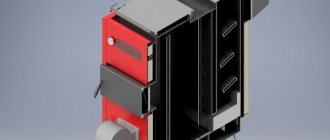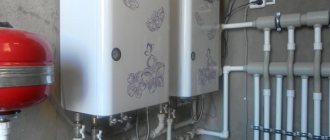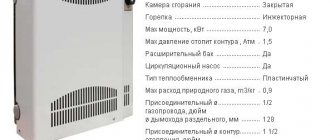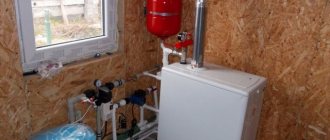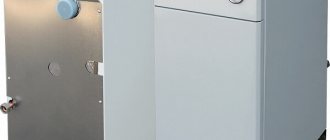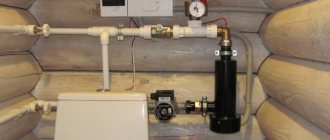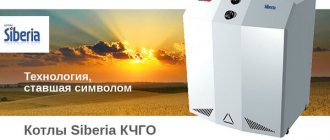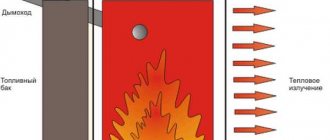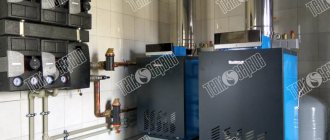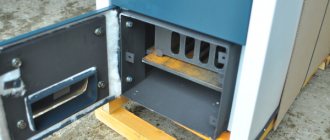Wood-fired mine boiler: description and features
The unit has high heat transfer, quickly heats the room, and is easy to maintain. The design of the firebox resembles a shaft and holds a large amount of firewood. One load of fuel is enough for 8-12 hours of operation of the heat generator.
The blower is designed in such a way that little air is supplied . There is not enough of it to ignite all the fuel, so the fire is localized in the lower layer. A fresh portion of firewood is supplied continuously. The combustion does not stop until all the fuel is gone. Due to this feature, the units in question are called long-term bottom-burning boilers.
The top layer of firewood smolders, forming pyrolysis gases. They are drawn by air into the secondary chamber, where they burn. The thermal energy of gases and open flames heats the heat exchanger.
Description of equipment
Long-burning mine boilers are an effective technology that is characterized by the longest possible fuel burning time and unique design features. The presence of a fuel chamber with increased dimensions eliminates the need for frequent loading, and thanks to the special design of the blower, slow combustion is ensured with the release of a large amount of heat.
The most widespread today are two designs of mine boilers:
- Pyrolysis.
- With normal combustion.
Both of these designs have two chambers, one of which contains a heat exchanger, and the second is used for burning fuel. The shaft-type boiler with bottom combustion is characterized by a simple design and has a firebox as high as the entire unit, which makes loading significantly easier. The combustion chamber resembles a shaft in appearance, which served as the name for heating equipment of this type.
In this video we will look at a mine boiler:
The heat exchanger chamber is made using classic fire tube technology. Inside this compartment there are numerous pipes through which a heat exchanger circulates, heated by hot air coming from the firebox. The chimney can be made either in the form of a vertical pipe or a coaxial type, which is discharged through the nearest wall to the street.
Read more: DIY chimney.
Mine boilers for long-term bottom burning with wood received a modified design, which made it possible to ensure the longest possible combustion. This boiler is supplemented with the following elements:
- In additional chambers located under the heat exchanger, carbon monoxide is burned, which improves the efficiency of the boiler.
- Pipes with numerous small holes are installed in the pyrolysis chamber, which allows the supply of air necessary for the combustion of carbon monoxide.
- Directly above the pyrolysis chamber there is a valve, which allows you to reduce and increase the intensity of fuel combustion.
This is interesting: which firewood produces the most heat.
Design and principle of operation of the boiler
There are several types of mine heat generators, differing in the design of the combustion chamber. One of the most popular is the Kholmov boiler, named after the inventor.
It consists of:
steel body;
- fuel mine;
- compartment with a heat exchanger;
- doors;
- grate;
- ash pan;
- chimney pipe;
- threaded pipes for connecting water heating.
Volatile units are equipped with a smoke exhauster, a controller that controls the combustion process, and a safety system. Units that operate without electricity are in great demand. The mode is controlled by a thermostat.
The mine wood heat generator has 2 vertical chambers: combustion and heat exchanger. The firebox is located at full height, firewood is loaded through the hatch from above. The second compartment houses the pipes through which the coolant circulates for the water heating system.
Heat generation occurs in 2 ways: from full combustion of fuel and afterburning of pyrolysis gases in the lower part of the secondary compartment. Little air flows through the ash pan, the fire covers only the lower layer of firewood up to 20 cm high, the rest smolder. In place of the burnt fuel, under its own weight, it slowly settles into the heat and the next portion is ignited.
Between the firebox and the second chamber there is a vertical partition with a small gap at the bottom. Through this hole, air is sucked into the flame. Here the highest temperature reaches +800° C. The released energy is transferred to the heat exchanger.
Due to the high temperature, organic compounds are formed from the smoldering wood that is on top. Together with the smoke, they are drawn in by the air entering through the ashpit, pass through the coals, turning into pyrolysis gases. They are burned in the second chamber, giving off heat to water circulating through the pipes.
Do-it-yourself long-burning mine boiler - drawings, how to make
The article describes in detail how to make a slow and ultra-long-burning boiler with your own hands using the drawings. The process, only at first glance, seems difficult and unique, but following the instructions from the article, you will be able to do no worse than the masters, the main thing is to carefully watch the video.
Drawing of a simple long-burning boiler
This design of a solid fuel boiler is quite simple. The heat exchanger can be made of sheet steel in the form of a “water jacket”. To maximize heat transfer efficiency and increase the contact area with flame and hot gases, its design includes two reflectors (protrusions inward).
Drawing of a simple solid fuel boiler
In this design, the heat exchanger is a combination of a “water jacket” around the combustion chamber and an additional slot-like sheet metal register in its upper part.
Diagram of a boiler with a slot-type heat exchanger
1 - chimney; 2 - water jacket; 3 - slot heat exchanger; 4 - loading door; 5 - firewood; 6 — lower door for ignition and cleaning; 7 - grate; 8 - door for regulating air supply and cleaning the ash pan.
In these options, the “water jacket” is supplemented with heat exchange registers made of pipes in the upper part of the combustion chamber. In addition, such units are designed for cooking food on them. Option 4 is more powerful and has a top loading door.
Rice. 3 Designs of solid fuel boilers with additional registers and hob
1 - firebox; 2 - register made of pipes; 5 — return pipe; 6 - supply pipe; 7 - upper loading door; 8 — lower door for ignition and air supply; 9 — loading door; 10 - chimney; 13 — grate; 14,15,16 — reflectors; 17 - damper; 19 — water jacket; 20 - ash pan; 21 - hob.
Top combustion boiler
This unit differs from the previous ones - firstly, in its shape (it has a round cross-section and can be made from pipes of different diameters), and secondly, in the method of burning fuel in it (it is burned in it from top to bottom). In order to ensure such a combustion process, it is necessary to provide air supply from above, directly to the combustion site. This function here is performed by an air supply telescopic pipe, which rises up when loading fuel and falls down after igniting the fuel. As it burns gradually, the pipe falls down under its own weight. A “pancake” with blades is welded to the bottom of the pipe to ensure uniform air supply.
To ensure better fuel combustion conditions, an air heating chamber is located in the upper part. The air supply, and therefore the burning rate, is regulated by a valve at the entrance to this chamber from above. The heat exchanger here is made in the form of a “water jacket” around the combustion chamber.
Drawing of a top combustion solid fuel boiler
1 - outer wall (pipe); 2 - inner wall; 3 - water jacket; 4 - chimney; 5 — telescopic air supply pipe; 6 — air distributor (metal “pancake” with ribs; 7 — air preheating chamber; 8 — air supply pipe; 9 — supply pipe with heated water; 10 — air damper; 11 — loading door; 12 — cleaning door; 13 — pipe with water from the system (return); 14 — cable controlling the damper.
Boiler with pyrolysis combustion of solid fuel
The difference between this design is that solid fuel does not burn in it, as in a conventional one, but if there is a lack of primary air supply, it is “distilled” into wood (pyrolysis) gas, which is burned in a special afterburner chamber when secondary air is supplied to it. Such a presentation can be either natural or forced.
Scheme-drawing of one of the variants of a pyrliz boiler
1 — draft regulator with temperature sensor; 3 - firewood; 4 - bottom door; 5 - grate; 6 — air damper for primary air supply; 7 - ash pan; 8 — grate; 10 — cleaning; 11 - drain; 12 — thermal insulation of the body; 13 — return (coolant supply from the system); 14 — nozzle; 15 — secondary air supply; 16 — chimney damper; 17 - pipe with heated water; 18 — damper; 21 — loading door; 22 - afterburning chamber.
Shaft type boilers
As already mentioned, a feature of such boilers is the presence of two chambers: a large vertical loading chamber (shaft) and a chamber with a heat exchanger. The fuel is ignited from below in the first chamber and the flame enters the other through a hole, where it transfers its energy to the coolant through a heat exchanger.
Such boilers can be either with conventional fuel combustion or with pyrolysis. In the first case, all the necessary air is supplied through the lower door, and the combustion products, after passing through the heat exchanger, are removed into the chimney. In the second case, a limited amount of primary air is supplied to the combustion site, where the wood burns, releasing pyrolysis gas. In addition, such structures are equipped with an additional afterburning chamber, where secondary air is supplied and gas is burned. At the top of the heat exchange chamber there is a valve that opens when ignited and allows the flue gases to escape directly into the chimney.
Drawing diagram of a shaft-type boiler with an afterburner chamber
1 — primary air supply damper; 2 - lower door for ignition and cleaning; 3 - grate; 4 - firewood; 5 — loading door (can be located on top); 12 - pipe with heated water (supply); 13 — starting valve; 14 — chimney damper; 15 - heat exchanger; 16 — secondary air supply; 17 — afterburning chamber; 18 — return; 19 — drain; 20 - cleaning; 21 - damper; 22 — grate; 25 - ash pan.
Diagram of a shaft-type boiler with lining of the inner surface of the combustion and afterburning chambers
Do-it-yourself solid fuel boiler for ultra-long burning
A homemade heater will have the following design:
- The firebox is a “box” 460 mm deep, 360 mm wide and 750 mm high with a total volume of 112 liters. The fuel load volume for such a combustion chamber is 83 liters (the entire volume of the firebox cannot be filled), which will allow the boiler to develop power up to 22 - 24 kW.
- The bottom of the firebox is a corner grate on which the firewood will be placed (air will flow into the chamber through it).
- There should be a 150 mm high compartment under the grate to collect ash.
- The 50 liter heat exchanger is mostly located above the firebox, but its lower part covers it on 3 sides in the form of a 20 mm thick water jacket.
- A vertical flue pipe connected to the top of the firebox and horizontal flame pipes are located inside the heat exchanger.
- The firebox and ash pan are closed with sealed doors, and air is taken in through a pipe in which a fan and gravity damper are installed. As soon as the fan turns off, the damper lowers under its own weight and completely blocks the air intake. As soon as the temperature sensor detects a decrease in the temperature of the coolant to a user-specified level, the controller will turn on the fan, the air flow will open the damper and a fire will break out in the firebox. Periodic “shutdown” of the boiler in combination with an increased volume of the firebox allows you to extend operation on one load of fuel up to 10 - 12 hours with wood and up to 24 hours with coal. The automation of the Polish company KG Elektronik has proven itself well: a controller with a temperature sensor - model SP-05, a fan - model DP-02.
do-it-yourself solid fuel boiler with extra long burning time
The firebox and heat exchanger are wrapped in basalt wool (thermal insulation) and placed in the housing.
The process of making a boiler with your own hands.
First of all, you need to prepare all the necessary preparations:
- Steel sheets 4 - 5 mm thick for making a firebox. Alloy steel of heat-resistant grades 12Х1МФ or 12ХМ (with additions of chromium and molybdenum) is best suited, but it needs to be welded in an argon environment, so the services of a professional welder will be needed. If you decide to make a firebox from structural steel (without alloying additives), then you should use low-carbon grades, for example, Steel 20, since high-carbon grades may lose their ductility due to exposure to high temperatures (they are hardened).
- Thin sheet steel 0.3 - 0.5 mm thick, painted with a polymer composition (decorative cladding).
- 4mm structural steel sheets for the body.
- Pipe DN50 (fire pipes inside the heat exchanger and pipes for connecting the heating system).
- Pipe DN150 (pipe for connecting the chimney).
- Rectangular pipe 60x40 (air intake).
- Steel strip 20x3 mm.
- Basalt wool 20 mm thick (density - 100 kg/cubic m).
- Asbestos cord for sealing openings.
- Factory made door handles.
Welding of parts should be performed with MP-3S or ANO-21 electrodes.
DIY heat exchanger for a solid fuel boiler
First, the firebox is assembled from two side, one rear and one upper walls. The seams between the walls are made with full penetration (they must be airtight). A 20x3 mm steel strip is welded horizontally from below to the firebox on 3 sides, which will serve as the bottom of the water jacket.
Next, to the side and rear walls of the firebox, you need to weld short pieces of small-diameter pipe in a random order - the so-called clips, which will ensure the rigidity of the heat exchanger structure.
Now the outer walls of the heat exchanger with pre-made holes for the clips can be welded to the bottom strip. The length of the clips should be such that they slightly protrude beyond the outer walls, to which they need to be welded with a sealed seam.
In the front and rear walls of the heat exchanger above the firebox, coaxial holes are cut into which flame tubes are welded.
All that remains is to weld the pipes to the heat exchanger for connection to the heating system circuit.
Homemade sheet metal boiler
Boiler assembly
The unit must be assembled in the following sequence:
- First, the body is made by attaching the side walls and frames of the openings to its bottom with short seams. The bottom frame of the ash pit opening is the bottom of the housing itself.
- From the inside, corners are welded to the body, on which the firebox grate pan (grid) will be placed.
- Now you need to weld the grill itself. The corners of which it consists must be welded with the outer corner down, so that the air coming from below is evenly distributed over the two inclined surfaces of each corner.
- Next, a firebox with a heat exchanger is welded to the corners on which the grate is laid.
- The doors of the firebox and ash pan are cut from steel sheet. From the inside they are framed with a steel strip laid in two rows, between which an asbestos cord must be laid.
Next, a smoke exhaust pipe and an air duct with a flange for installing a fan are welded. The air duct is led into the boiler through a hole in the middle of the rear wall just below the grate.
Now we need to weld the mating parts of the door hinges and several 20 mm wide brackets to which the casing will be attached to the boiler body.
The heat exchanger must be lined on three sides and on top with basalt wool, which is tightened with a cord.
Since the insulation will be in contact with hot surfaces, it should not contain phenol-formaldehyde binders and other substances that emit toxic volatile substances when heated.
The sheathing is screwed to the brackets using screws.
An automation controller is installed on top of the heat generator, and a fan is screwed to the air duct flange.
The temperature sensor must be placed under the basalt wool so that it is in contact with the rear wall of the heat exchanger.
If desired, the boiler can be equipped with a second circuit, allowing it to be used as a water heater.
The circuit has the form of a copper tube with a diameter of about 12 mm and a length of 10 m, wound inside the heat exchanger on flame tubes and brought out through the rear wall.
For information for the article, we thank our colleagues: microklimat.pro, v-teple.com
How to heat properly
To realize the benefits of a shaft boiler and increase the efficiency of heat transfer, two points are important: the quality of the fuel and proper installation. Hardwood (for example, coniferous) firewood contains a lot of resins, which accumulate on the walls of the chambers and reduce efficiency. Wood briquettes and pellets are easy to use, burn well, but their price is higher.
Ignition and adjustment of the boiler take a little time, but the quality of the unit’s operation depends on the correct completion of this stage.
Follow a simple algorithm:
- They put a little fuel on the grate and set it on fire, like in a wood-burning stove. After a few minutes, the flame flares up. When it becomes strong, the boiler enters operating mode.
- Reload fuel. The unit begins to operate in pyrolysis mode.
At least half of the stack should be dry firewood. Logs of high humidity are placed on top: by the time they burn, they have time to dry.
A common mistake made by users is incorrectly stacking firewood, which causes it to get stuck in the shaft. The boiler is designed on the principle of bottom combustion, so the fuel must lower itself to the heat.
To prevent combustion from being interrupted, the logs should be slightly shorter than the distance between the walls of the loading compartment. The firewood is laid across the shaft opening: then they can freely fall down.
How to increase burn time
Many people want to increase the operating time of the heat generator from one load of fuel in order to replenish the supply less often. Two common methods are used: wet firewood and minimal air supply.
Attention: it will not be possible to significantly increase the burning time . Such methods have more disadvantages than advantages.
For the most efficient operation of the unit, boiler manufacturers recommend using firewood with a moisture content of no higher than 20%. Raw fuel reduces boiler efficiency because part of the energy is spent on moisture evaporation. In addition, a lot of soot and resin are formed, all of which settles on the walls, reducing the efficiency of heating water in the heat exchanger. The gas channels narrow and the boiler smokes.
Equipment manufacturers allow the use of fuel with a moisture content of up to 45% or higher, taking into account the possible negative consequences of such use.
A similar result is caused by cutting off the oxygen supply below the normal level. Combustion slows down, the wood smolders, and excess soot is formed, which settles on the walls, reducing the efficiency of heat transfer. Closing the damper on the chimney leads to similar consequences.
Efficient operation of the boiler is possible at 60-90% power. It is possible to increase the burning time, but within small limits. If this is abused, the house will not warm up as well, and fuel costs will be higher.
Operating principle of shaft type boilers
For most long-burning solid fuel boilers, you need to use high quality fuel. And mine boilers are not so fancy. For the firebox, you can use firewood with a humidity of up to 45%. The boiler digests raw wood and produces the required amount of heat over a long period of time. Fuel loading must be done at least once every 12 hours.
The mine boiler got its name due to its design. The combustion chamber and combustion chamber look like a shaft. The boiler has 2 shafts: a heat exchanger chamber and a fuel chamber. In the second, fuel is loaded in layers, and combustion occurs from bottom to top. Such equipment can be called a bottom-burning boiler.
Let's take a closer look at the operating principle of such a boiler:
- It is necessary to create a fireplace on the grates.
- The main fill must be laid in layers on top of the burning fuel.
- Due to the constant flow of air, the upper layers do not flare up.
- Under its weight, the fuel falls down and takes the place of burnt firewood.
- The firewood that is located on top has time to dry out while the bottom layer burns out.
- If there is no air at the bottom of the shaft, pyrolysis occurs and wood gas is formed. Pyrolysis gas enters the second firebox, which is the main source of thermal energy.
Pyrolysis is the process of generating a gaseous substance by reacting with firewood. If there is no oxygen, then during smoldering a volatile substance is released, which, when interacting with oxygen, releases heat.
The combustion shaft can be made in different forms. For example, the shaft is made with a flat heat exchanger. Some models have a water-heating heat exchanger or a heat-exchange fire-tube device, which is installed in the combustion shaft. This type of heat exchanger is considered the most efficient. In the picture you can see the structure of a shaft-type boiler.
In order to increase the combustion intensity, secondary hot air is supplied. To achieve a high temperature in the firebox, the walls of the mouth of the combustion chamber are lined with fireclay bricks.
Advantages and disadvantages
Main advantages compared to other types of boilers:
- Ability to burn fuel of any quality. In addition to firewood, wood briquettes, pellets, and wood processing waste are used.
- Efficiency reaching 85%.
- Ability to adjust power.
- Long-term operation without supplying additional fuel.
- Convenient design with separate hatches for loading firewood and removing ash.
- Operational safety. The possibility of carbon monoxide entering the room is zero.
Disadvantages include increased soot formation and tar deposition on the walls. Periodic cleaning is required to maintain optimal heat output. In addition, the large size and weight of the equipment complicate installation.
How to make a mine boiler at home
There are many drawings of long-burning units for self-production.
It is impossible to completely replicate an industrial design, but many craftsmen manage to create an analogue.
To assemble a Kholmov boiler at home, you will need to make:
- firebox;
- loading shaft;
- ash chamber;
- grate;
- heat exchange compartment;
- doors;
- dampers;
- chimney.
The most important thing is to make the heat exchanger correctly. If you place it too low, the boiler will instantly boil, which will lead to unpredictable consequences.
The main advantages and disadvantages of shaft-type boiler equipment
For a country house or a country guest house, this type of heating equipment is a real godsend. It is not always possible to obtain the ideal fuel for use. Dry firewood in the cold and damp season is quite rare. For other heating devices, this condition of the firewood can cause poor performance of the heating equipment. Mine heating devices do not suffer from such disadvantages.
By installing such heating equipment in your home, you get the following benefits:
- the unit operates on almost any type of solid organic fuel;
- the units are capable of operating in different operating modes (wide power range);
- the equipment is economical. One bookmark is enough for 12-24 hours;
- long and continuous operation throughout the heating season;
- units of this type are energy independent;
- simplicity of design and ease of maintenance (ash is removed during operation of the unit);
- high level of safety of the operating unit.
Note: When assessing the advantages of shaft-type boiler equipment, do not forget that, like any other boiler, this unit requires proper piping. Otherwise, you risk losing all the benefits of this equipment.
Other disadvantages of this type of boiler equipment include the simplicity of its design. Here you need to be careful and attentive! Incorrect interpretation of the basic parameters of the equipment and superficial knowledge of the operating principle of shaft-type boilers can lead to unpleasant consequences.
At first glance, the design of the heating device is simple and understandable. Many people try to make such equipment themselves. Attempts are not always successful due to the fact that it is very important to correctly and accurately position the heat exchangers. In the combustion chamber, the temperature reaches 450-5000C and if the water-tube heat exchanger is located low, your boiler will instantly boil, which will lead to dire consequences.
Depending on the design of the combustion chamber, heating devices are divided into the following types, according to the name of the creators. The main part of the heating units used in everyday life are Kholmov boilers and Efimov heating devices.
Step-by-step instructions for making a wood-fired mine boiler
They start by studying the drawing, after which they transfer the dimensions of the parts onto sheet metal. The elements are cut out and the body is welded.
Next, proceed to the manufacture and installation of internal parts:
- A partition is cut to size for installation between the boiler chambers. Holes are made in it: on top and slightly above the grate.
- The part is installed inside the body and welded.
- On the firebox side, a valve is installed on the upper hole of the partition. The chimney pipe is installed on the reverse side.
- Steel grates are welded: cast iron ones quickly deform. You can make them yourself from sheet metal or buy them.
- A hole for the ash pan is cut out in the lower part of the firebox. A similar operation is performed in the wall of the heat exchanger chamber.
- Necks are welded to the holes made, protruding outward by 6 cm and inward by 3 cm.
- Prepare the base for the water jacket: corners are welded horizontally from the inside of the second compartment. The distance to the top should be 4 cm, the bottom row should be located level with the bottom of the afterburning chamber.
- A water jacket and a pipe heat exchanger are installed. The finished part is inserted inside and scalded.
- In the afterburning chamber, the bottom is welded at the same level as the grate. At the internal partition, a third of the part is located horizontally, then it rises according to the drawing.
- A hole is cut above the bottom for the air pipe. They make a lot of holes in it and weld it into the body. The pipe extends 60 mm outwards, and there are no holes in this section.
To make it more convenient to install the heat exchanger, the side of the housing on the side of this chamber is welded after installing the water jacket.
The inside of the boiler chambers is lined with fireclay bricks. For the passage of gases, holes are left opposite those made in the metal.
Manufacturing of a mine pyrolysis boiler
The most popular today are the improved designs of pyrolysis boilers, which have high efficiency, save fuel, and can operate on one load for 24 hours or more, providing high-quality heating of the room. Due to the simplicity of the design of such an installation, it can be made independently, even with minimal experience in welding.
Required tools and materials
If you have a diagram for manufacturing a mine pyrolysis boiler on hand, it will not be difficult to complete it. This work does not require the use of any complex professional equipment; you can get by with the following tools and materials:
- Gas cutter.
- Welding machine.
- Various carpentry tools.
- Sheet steel 5 and 2 millimeters thick.
- Pipes of various diameters.
- High temperature fireclay brick.
- Corners 4 by 4 centimeters.
- Double ash door with asbestos gasket and valve for adjusting the air supply.
- Three valves that are necessary for the chimney and partitions between the chambers.
- Doors for servicing the heat exchange chamber.
- Galvanized steel sheet.
- Basalt wool.
A prerequisite for the production of a high-quality solid fuel mine boiler will be the availability of the appropriate manufacturing scheme for such equipment. You can make a drawing yourself, but it’s easier to find it in open sources on the Internet. Subsequently, all work, in particular metal cutting, is carried out on the basis of existing drawings and documentation.
When choosing a specific boiler manufacturing drawing, you should pay attention to the volume of the combustion chamber. The larger it is, the longer the bottom combustion mine boiler will operate on one refill. It is possible to manufacture such equipment, the size of the combustion chamber of which will allow the boiler to heat the room for two to three days, which greatly simplifies the maintenance of equipment and living in a private house.
Execution of the main part
The main part of the boiler is usually understood as a homemade body, which is divided into several chambers. Between them there are partitions and valves, which allow you to regulate the volume of air entering the combustion chamber . The body is made as follows:
- They study the drawing and determine the dimensions and method of cutting the sheet metal.
- Using a lining, a cutting pattern is made on a sheet of metal and the sheet steel is cut using autogenous welding or a plasma cutter.
- The side parts of the body are welded with a double seam.
- Two holes are made in the partition between the heat exchange and fuel chambers, one of which is located at the top, and the second at the level of the grate.
- The combustion chamber blank is installed in the body and secured by welding. A valve is attached to the upper hole of the partition and the base is welded.
Create a warm atmosphere in your home with pyrolysis boilers
- A grate is made by cutting narrow longitudinal holes in sheet steel using a lining. You can use a purchased cast iron or steel grate, which will somewhat simplify making a boiler with your own hands.
- The grate is welded or installed on the corners.
- The necessary holes are cut out in the side walls, which will be required for the combustion chamber doors and ash pan.
- Two rows of profile pipes or corners are welded inside the thermal chamber. Subsequently, elements of a water jacket will be attached to them; it is not recommended to place it inside the pyrolysis chamber, as this may disrupt the process of afterburning of gases.
- A heat exchanger is installed and welded into the housing, inside of which there is a water jacket. It is made from pipes with a diameter of 2.5 centimeters.
- At the level of the grate, a partition is welded, which serves as the bottom of the fuel afterburning chamber.
- A hole is cut out in the bottom part, which will be required for the air supply pipe.
- To supply air to the pyrolysis chamber, a pipe with a diameter of 5 centimeters is used, in which a large number of small holes are drilled. A blind valve is welded at the end of the pipe.
- The walls of the combustion chamber are lined with fireclay bricks. If necessary, it is trimmed, after which, using a high-temperature solution, masonry is carried out.
- Additionally, brickwork can be insulated with basalt wool, which improves the thermal efficiency of the equipment.
This completes the production of the main part. All that remains is to construct a heat exchanger, inside which a liquid will circulate, heated by hot gases and subsequently releasing heat through radiators installed in the house.
Tips and tricks for use
Before launching, tests are carried out: air is pumped under a pressure of 1.5 atm. Observe the seams, previously coated with soapy water, to see if there is any depressurization.
A fully loaded boiler reaches rated power in 20 minutes. An average of 3 kg of firewood is consumed within an hour. The duration of combustion in normal mode depends on the capacity of the hopper.
If the weather does not require high coolant temperatures, many units switch to smoldering mode. Manufacturers advise loading less fuel. Smoldering has a bad effect on the condition of gas ducts and the internal surface of the boiler.
Of all solid fuel units, mine ones are the most convenient, efficient, and unpretentious. For country houses, this is the best solution to the heating problem.
Pros and cons of shaft-type boilers
A mine boiler is perfect for heating a country house. It is not always possible to use high quality fuel for heating. During the cold season, the firewood in a country house will most likely be damp and cold. If you use such fuel for another boiler, the equipment will not work well. And mine boilers will operate with high efficiency.
If you buy a shaft-type heating boiler, you will get many advantages:
- Economical equipment. The boiler operates on one charge from 12 to 24 hours.
- The boiler can operate on any type of solid fuel.
- The boiler can operate in different operating modes.
- Equipment safety.
- Long-term operation of the boiler throughout the heating season.
- Energy independence.
- Ease of use and simplicity of design.
When choosing a shaft-type heating boiler, you should understand that it requires good piping, like any other boiler. If the piping is done incorrectly, the equipment will not be effective and economical.
The disadvantage of such a boiler is the simplicity of the design. Because ignorance can lead to unpleasant consequences. Due to the simple design, many people want to do the installation and wiring themselves. But it is not always possible to do this correctly. It is important to install the heat exchanger correctly and accurately. The temperature in the combustion chamber is about 500 degrees and if the heat exchanger is located too low, the boiler will boil and fail.
Mine-type heating boilers can be divided into 2 types depending on the design of the firebox: Efimov boilers and Kholmov boilers.
